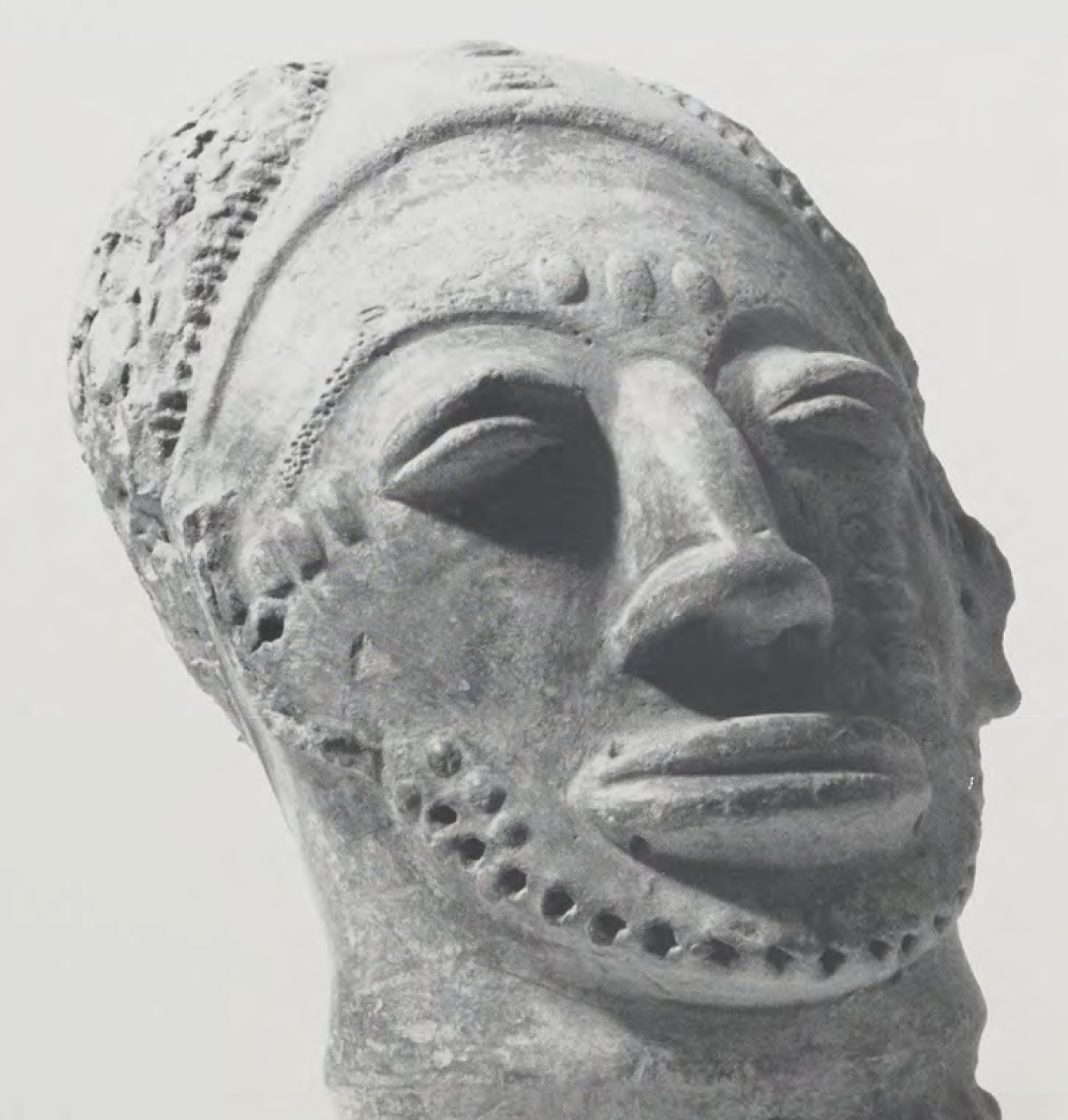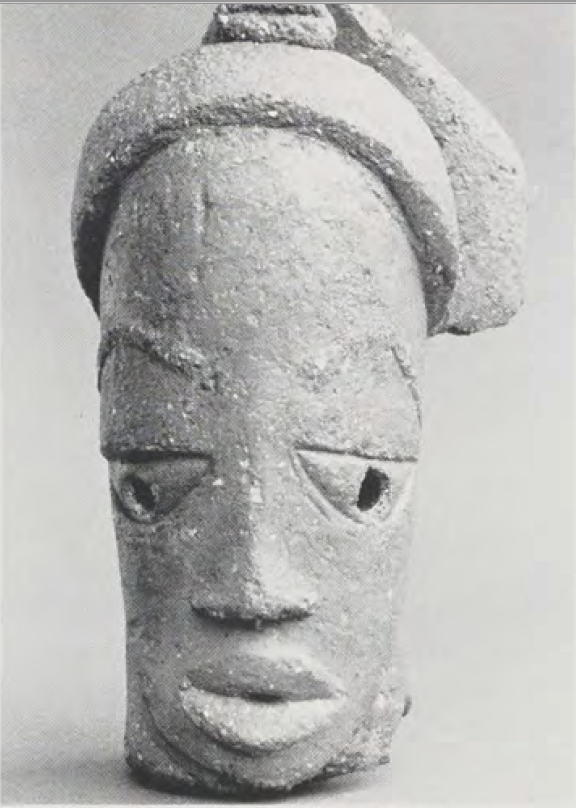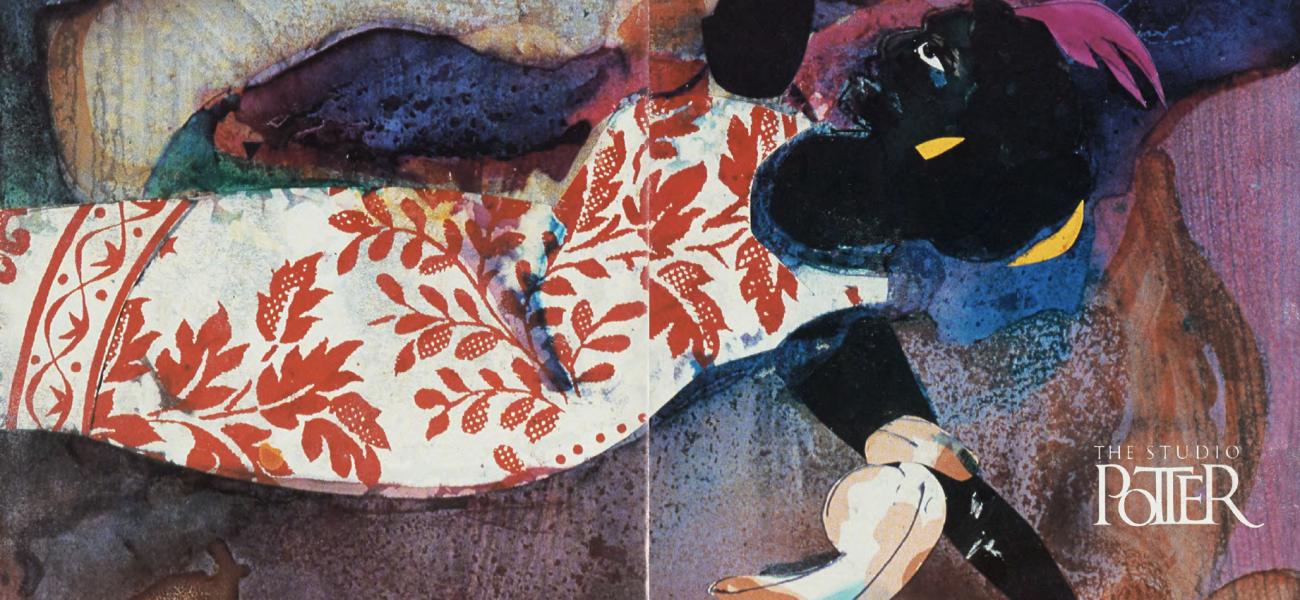African Art: Traditional and Contemporary Pottery
It is customary in Western societies for the arts to be considered under such categories as arts and crafts. But the question is: how tenable is the application of such concepts to the arts of traditional Africa?

Scholars have attempted to answer this question. Claire Polakoff cites Leon Siroto's discussion of the distinctions that are often made between arts and crafts, the one an expression of a supernatural world, the other of a tangible order. The observation is then made by Siroto that in traditional African societies, distinctions such as these are mostly not relevant in that the conceptualization of the visible and invisible worlds does not obey the same principles subscribed to by industrialized societies.
Thus, in traditional African societies, tools and furniture, ornaments and garments, utilitarian and functional objects are not often considered as belonging to higher or lower, secular or spiritual planes based mainly on types. In discussing pottery and pottery-sculpture, William Fagg and John Picton introduce an interesting dimension to this topic by noting the differentiations occasioned by forms and techniques, and the role of culture in ascribing meanings to objects on the basis of manufacture. They make it emphatically clear that pottery or pottery-sculpture cannot be separately categorized as art or craft in Africa because, unlike in Europe, where such distinctions are often influenced by who the producer is, the potter and potter-sculptor are often indistinguishable.
Indeed, some have questioned the imposition of Western principles of art and aesthetics on the traditional arts of Africa. In this connection, observable sociocultural differences between the arts of Western and non-Western peoples are often used as examples. The study of traditional African art has shown, for example, that the arts are often the exteriorization of secular and spiritual philosophies. Together, the arts constitute an interrelated and mutually dependent system of expression: a symbolic or literal system of communication involving sculpture, poetry, costumes, dance, songs, music, and theater. The point is often made that the conditions that stimulated the production of art in traditional Africa and the network of social, cultural, and religious factors that define the artist are often so radically different from the artistic climate of the West as to warrant questioning the rationale behind treating African objects as artworks in the Euro-American sense.
In Europe and North America, traditional visual expressions from Africa that were regarded as or created expressly for magical, agricultural, votive, commemorative, religious, or personal purposes have not become art by metamorphosis (Maquet 1979:33). Thus, the Western concept of fine and applied arts the intellectualization of the arts-has contributed immensely to the categorization of much of the material culture of traditional Africa under the arts and crafts rubrics. Within a system where personal shrines rather than public museums constituted the cultural norm, where fluid and spontaneous community festivals left no room for tranquil and neatly organized exhibits, where art was a channel of personal and collective survival rather than mere decorative adjuncts meant for private walls or public places, drawing distinctions between arts and crafts may serve more academic than practical purposes.
TRADITIONAL AND CONTEMPORARY ARTS
Drawing distinctions between art and traditional African societies, as well as the use of the term "non-Western," underlines the necessity to recognize changes that have occurred in Africa, particularly within the last century. To understand the limited relevancy of certain terms and to differentiate between ancient, traditional, and current trends in the arts, a categorization of African art into traditional and contemporary domains becomes a useful classification. For further clarification, we may ask: What are the major characteristics of twentieth-century African art? What is the current form of artistic expression there? To what extent has acculturation or Westernization influenced the arts of Africa?
Our focus here will be on the West African subregion, although much of what we discuss also applies to Africa south of the Sahara Desert. Although Portuguese traders traveled down the Guinea Coast of Africa and established early contact with some African peoples, it was not until the nineteenth century that European contact with Africa began to produce alterations, albeit minor, in the arts. What is now generally accepted as African art was, for a long time, considered by early European dealers as curious objects produced by those considered primitive according to the prevalent definitions of civilization. Darwin's biological evolutionism and the industrial revolution contributed significantly to an ethnocentric perspective that measured human achievement by European standards. We can understand why interest in African objects was limited to their value as ethnographic implements, not as art in the Western sense.
Changes in the arts were conceptual and nominal at first. In some instances, contact with the West expanded the artist's visual repertoire to account for the presence of the white man, often depicted with a pith helmet and tobacco pipe.
As European colonialists settled down to govern the arbitrarily demarcated geographical territories in Africa (which the Berlin Conference of 1884 granted them), alien modes of social, religious, and political intercourse were introduced. Over time, this resulted in major alterations. For example, attacks on traditional religions by missionaries drove a wedge between art and society, and regulatory bodies, known more as secret societies that, in many instances, used the arts as emblems of religious and juridical powers, fell into disfavor. (In fact, some postcolonial governments in Africa have outlawed their existence.) The establishment of missionary schools ensured the entrenchment of Western values and resulted in cultural disorientation and the erosion of the base of traditional education. The apprenticeship method that promoted the inculcation of artistic skills in youths lost its effectiveness, while the pursuit of new skills and concerns weakened the continuity of initiation, association, or age-grade systems. The importation of Western merchandise encouraged the abandonment of local ware, dictating novel concepts of patronage. Traditional rulers, who once provided sanctuary for artists in their palaces, were hamstrung by new political orders that eroded their economic, social, and political status.
Today there is a proliferation of art departments in West African institutions. The subject is routinely taught in many secondary schools across West Africa. Alongside the development of formal art institutions were art workshops that were established to cater to the needs of talented but educationally disadvantaged Africans. Some of the most popular workshops in West Africa are the Mbari Mbayo School of Osogbo in Nigeria, established in 1%2 by Ulli Beier with the assistance of Susanne Wenger and Georgina Beier, and the Abuja Training Center that Michael Cardew established in Nigeria for training potters.
It is apparent that contemporary Africa is in flux. The ongoing transition, as reflected assertively in the visual arts, contradicts the sedate systematization of African art along the classic ethno-geographic and stylistic axis. Equally apparent is the role of the expatriate in the discovery and study of ancient and traditional arts of Africa. Indeed, no consideration of the development in the visual arts of Africa within the last century can be regarded as comprehensive without a discussion of the impact of expatriate interests.

POTTERY IN AFRICAN ART
The oldest art form known so far in subSaharan Africa is the pottery-sculpture from Nigeria. Generally referred to as Nok terracotta figures, they have been dated from 500 B.c. to A.O. 200.
A casual find forty-five years ago by a worker at a tin-mining deposit in northern Nigeria revealed a beautiful terracotta head, which was promptly used as a scarecrow on the man's farm (Eyo 1980:3). Many other finds followed, and the number of Nok terracotta figures now totals more than one hundred and fifty.
What were the Nok terracottas used for? What is the significance of the flared lips and dilated pupils? Who made these terracottas: men or women, priests or acolytes? We may never have conclusive evidence about all aspects of Nok culture.
It is known, however, that the Nok culture was the first to demonstrate knowledge of iron technology in sub-Saharan Africa. To judge from the artistic and technical competence of the terracottas, the Nok potters must have had an excellent understanding of their materials.
This can also be said of the pottery-sculptures of the Yoruba city of lle-lfe, also in Nigeria. The German ethnologist Leo Frobenius first brought these startlingly realistic pottery works to world attention following his visit to that city in 1910. Although there is no unanimity on the hypothesis that Nok was artistically ancestral to lfe, it is generally agreed that in their degree of competence and the sureness of their hands, these two cultures possessed identical technological proficiency. The schematized assertiveness of much of Nok terracottas and the fluid, poetic realism of lfe pottery-figures encourages one to draw the inference that a physical expression of tangible and intangible worlds was involved in both instances. While extant bits and fragments of the human figure from Nok reveal an aesthetic taste for hair beautification and body ornamentation, the use of potsherds to pave public and religious places in ancient lfe and the remarkable terracotta portraits depicting the head of the Oni (traditional ruler) suggest a religiopolitical connection.
In West Africa, pottery is used for utilitarian, magical, social, commemorative, and religious purposes. In eastern Nigeria, among the Igbo, Ibibio, and the Kalabari, pots are used for musical instruments (Nicklin 1973). In earlier times, before pipe-borne water and the refrigerator became a feature of everyday life, pots were used for a variety of domestic chores, including the storage and cooling of water and the preparation of meals. Even now, in some societies, local beer or palm wine is brewed in large pots that have been inserted halfway into holes dug in the ground. Pots are used as receptacles for items ranging from local dye and foodstuffs to palm oil and herbal concoctions for protective and healing processes.
In some cultures, like the Dakakari in northwestern Nigeria and the Akan in Ghana, pottery-sculptures are used as part of the rituals connected with the dead. Among the Dakakari, pottery-sculptures are erected on the graves of those marked for honor. The Akan produce pottery-heads that become the focus of attention during the post-interment ceremonies commemorating the departed, a tradition more than three centuries old. These terracotta heads are often located at or around the grave of the deceased or in a shrine so dedicated, where they are treated as a medium of exchange between the dead and the living. Quite distinct from figural pottery, but clearly related to funeral ceremonies among the Ashanti in Ghana are the sacred pots that are used by the relations of the departed. These abusua kuruwa (family pots) are used as receptacles for the shaved hair of grieving relations before being deposited, together with other items, at "the place of the pots."
Although the introduction of Western concepts has affected contemporary African art, pottery remains remarkably one art form that has demonstrated a capacity for flexibility, resilience, and synthesis. For example, pottery was made, with few exceptions, by women in traditional African societies. Today, it still is, although they no longer have exclusive control over the production of pottery. One reason for this is Western education. As art colleges were established, pottery or, as it was more elegantly called, ceramics became one of the standard art subjects. In the initial stages, ceramics majors were regarded as a weird group, as it was a time when many young African nations placed a greater premium on such disciplines as medicine, engineering, and law.
Today the situation has changed. The teaching of pottery in formal and informal institutions has significantly elevated the status of pottery as both an art and a craft. While formal art colleges in Africa tend to emphasize the elegance of form and the beauty of individuated expression, informal pottery centers appear to be concerned primarily with teaching the acquisition of skills and techniques.
There have been, however, instances where a synthesis of the old and the new, of craftsmanship and creativity, has been achieved. The first example is the experiment that the British potter Michael Cardew undertook in Ghana and Nigeria, while the second pertains to the efforts of Raphael Ige Ibigbami, a Nigerian potter, to stimulate interest in new-traditional pottery in Nigeria.
Michael Cardew had been teaching pottery in Ghana. In the nineteen-forties, he went to Abuja, Nigeria, where he established the Abuja Training Center. By the time he retired in 1965, the Center had acquired an international reputation through Cardew's pioneering work as well as through the unique style of Madam Ladi Kwali. By combining traditional pottery skills with modern techniques, Kwali imbued pottery with a creative touch that earned her national and international recognition. The Nigerian government showed its recognition of Ladi Kwali's excellence by issuing postal stamps that bore her image.
The second example is the work of Raphael Ige Ibigbami at the Obafemi Awolowo University in IIe-Ife. Ibigbami is a graduate of the Ahmadu Bello University in Zaria, the oldest art college in Nigeria. Through formal classes and informal workshops, Ibigbami seeks to impart his knowledge of pottery to Nigerian potters of various persuasions: from the young art student to the old casual lover of the art; from traditional potters-mainly women to professional experimentalists. People like Ibigbami effectively demystified pottery and expanded the frontiers of understanding and patronage that cut across the barriers of sex and status.
Contemporary Africa is a confluence of ideas and practices, some of which are still being resolved. Nowhere is this more visibly telescoped than in the arts. Pottery, the most practical of arts, provides in concept and physicality an excellent summary of change over time.
BIBLIOGRAPHY
Beier, Georgina. "Yoruba Pottery," African Arts, Vol. 13, No. 3, 1980, pp. 48-53, 92.
Cardew, Michael. Pioneer Pottery. London: Longmans, 1969.
Celenko, Theodore. A Treasury of African Art. Bloomington: Indiana University Press, 1983.
Eyo, Ekpo and Frank Willett. Treasures of Ancient Nigeria. New York: Alfred A Knopf, 1980.
Fagg, William. Nigerian Images. New York: Frederick Praeger, 1963.
Fagg, William and John Picton. The Potter's Art in Africa. London: The British Museum, 1978.
Maquet, Jacques. "Art by Metamorphosis," African Arts, Vol. 12, No. 4, 1979, pp. 33-36, 90-91.
Mount, Marshall Ward. African Art: The Years Since 1920. Bloomington: Indiana University, 1973.
Nicklin, Keith. "The lbibio Musical Pot," African Arts, Vol. 7, No. 1, 1973, pp. 50-54, 92. Polakoff, Claire. "Crafts and the Concept of Art in Africa," in African Arts, Vol. 12, No. 1, 1978, pp. 22-23.
Sassing, Allen. "Grave Monuments of the Dakakari," African Arts, Vol. 6, No. 4, 1937, pp. 36-39.
Wahlman, Maude. Contemporary African Arts. Chicago: Field Museum of Natural History, 1974.

